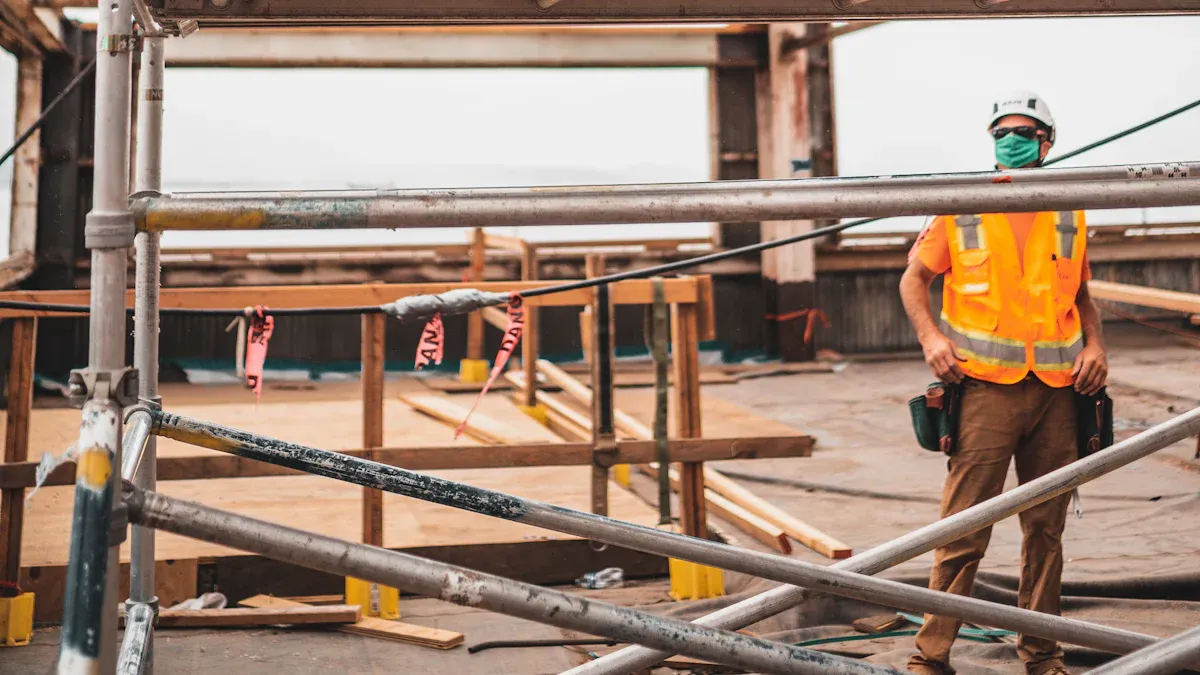In hazardous workplaces, safety takes center stage, and explosion proof phones play a vital role. These devices are built to prevent sparks or heat that could ignite flammable gases or dust. Whether it’s an emergency explosion proof telephone in a chemical plant or a mining explosion proof telephone deep underground, their rugged design ensures reliability. Even in public spaces, a public security telephone with explosion proof features can protect lives. These phones are more than tools—they’re lifelines in extreme environments.
What Are Explosion Proof Phones?
Definition and Purpose
Explosion proof phones are specialized devices designed to operate safely in hazardous environments. They prevent ignition of flammable gases, vapors, or dust, ensuring safety in high-risk areas. These phones are built with rugged materials, such as heavy-duty metal, to withstand extreme conditions. Some models feature explosion-proof enclosures, while others are intrinsically safe, meaning they limit electrical and thermal energy to avoid sparks. Certifications like ATEX, IECEx, and NEC ensure these devices meet strict safety standards across industries. Their primary purpose is to provide reliable communication while preventing potential explosions caused by electronic devices.
Key Industries That Use Explosion Proof Phones
Several industries rely on explosion proof phones to maintain safety and communication. The oil and gas sector leads the way, driven by its strong safety culture and the inherent risks of chemical exposure and fire hazards. Manufacturing and pharmaceutical companies also use these devices to monitor processes and comply with safety regulations. In the food and beverage industry, where products like flour and sugar can create combustible atmospheres, explosion proof equipment is essential. Mining operations and chemical plants also depend on these phones to mitigate risks in volatile environments.
How Explosion Proof Phones Differ From Regular Smartphones
Explosion proof phones differ significantly from regular smartphones in design and functionality. Regular smartphones lack the safety certifications needed for hazardous environments, making them unsuitable for such conditions. In contrast, explosion proof phones feature heavy-duty construction to contain explosions or prevent ignition. Intrinsically safe models limit energy output to avoid sparks. The table below highlights key differences:
| Feature | Explosion-Proof Smartphones | Intrinsically Safe Smartphones |
|---|---|---|
| Design | Heavy-duty, rugged construction | Lightweight and portable |
| Functionality | Contains explosions within the device | Limits electrical and thermal energy to prevent ignition |
| Maintenance | Requires periodic maintenance for seals and enclosures | Lower maintenance costs |
| Best Use Cases | Construction sites, industrial facilities | Oil & gas industry, chemical plants, mining operations |
These differences make explosion proof phones indispensable for industries where safety is non-negotiable.
How Explosion Proof Phones Handle Extreme Environments

Common Hazards in Hazardous Workplaces
Hazardous workplaces expose workers to a variety of risks that can compromise safety and productivity. These environments often include:
- Biological hazards like mold, bacteria, and insect bites.
- Chemical hazards from flammable materials, cleaning products, and welding vapors.
- Physical hazards such as extreme temperatures, radiation, and loud noise.
- Ergonomic hazards caused by repetitive movements or poor posture.
- Work organization hazards like workplace violence or excessive workload demands.
Explosion Proof Phones mitigate these risks by ensuring safe communication. Their explosion-proof cases and intrinsically safe designs prevent ignition in volatile atmospheres, offering workers a reliable lifeline in dangerous conditions.
Explosion-Proof Design and Safety Standards
Explosion Proof Phones are built to meet strict international safety standards. Certifications like ATEX (European Union) and IECEx (global) ensure these devices can operate safely in environments with flammable gases or dust. These standards require phones to either contain explosions within their casing or limit energy output to prevent ignition. By adhering to these regulations, manufacturers guarantee that their devices protect workers and comply with industry requirements.
Tip: Always check for ATEX or IECEx certifications when selecting Explosion Proof Phones for hazardous workplaces.
Materials and Engineering for Durability
The durability of Explosion Proof Phones comes from their robust materials and advanced engineering techniques. Common materials include:
| Material | Properties |
|---|---|
| Aluminum Enclosures | Lightweight, corrosion-resistant, excellent heat dissipation properties. |
| Silicone Rubber | Flexible, high-temperature resistance, excellent sealing properties. |
| Stainless Steel | Strong, durable, resistant to corrosion and extreme temperatures. |
| Cast Iron | High heat resistance, durable, suitable for harsh environments. |
Engineers also employ techniques like explosion-proof cases and intrinsically safe designs to enhance durability. Aluminum enclosures dissipate heat effectively, while silicone rubber seals protect against dust and water. These features ensure that Explosion Proof Phones remain functional even in the harshest conditions.
Key Features of Explosion Proof Phones

Explosion Protection Mechanisms
Explosion proof phones are designed with advanced mechanisms to prevent ignition in hazardous environments. These devices use either explosion-proof enclosures or intrinsically safe designs. Explosion-proof enclosures contain any internal sparks or heat, ensuring they don’t interact with the surrounding atmosphere. Intrinsically safe models, on the other hand, limit electrical and thermal energy to levels that cannot ignite flammable substances. Both approaches meet strict safety standards like ATEX and IECEx, making these phones reliable tools for high-risk industries.
Rugged and Impact-Resistant Construction
Durability is a hallmark of explosion proof phones. Their rugged construction allows them to withstand impacts, drops, and harsh conditions. Materials like stainless steel and cast iron provide strength and resistance to extreme temperatures. Silicone rubber seals enhance durability by protecting against dust and water. This robust design ensures the phones remain functional even in the toughest environments, such as mining sites or offshore platforms.
Advanced Communication Capabilities
Explosion proof phones come equipped with cutting-edge communication features that enhance workplace safety and efficiency. These include:
- GPS for real-time location tracking.
- High-resolution cameras for capturing detailed images in hazardous areas.
- IoT and wireless communication technologies for seamless integration with industrial systems.
- VoIP and SIP technology for stable calls and easy configuration.
Consider the case of an oil rig worker who detects a potential gas leak. With an intrinsically safe phone, they can immediately alert their team and prevent a potential disaster. Without such a device, the worker would have to leave the area to report the issue, wasting valuable time and potentially putting lives at risk.
Resistance to Environmental Factors (e.g., water, dust, temperature)
Explosion proof phones are built to resist environmental challenges like water, dust, and extreme temperatures. Silicone rubber seals protect against dust and water, ensuring the device operates reliably in harsh conditions. Waterproof models, such as the JWAT306 and JWAT307, feature IP66/67-rated enclosures. These enclosures allow the phones to function effectively in rain, dust storms, or even on offshore platforms. This level of protection makes them indispensable for industries operating in extreme environments.
Benefits of Explosion Proof Phones in Hazardous Industries
Enhanced Worker Safety
Explosion proof phones play a critical role in protecting workers in hazardous environments. These devices ensure reliable communication, which is essential during emergencies. They also prevent ignition sources that could lead to explosions, reducing the risk of accidents. By complying with safety standards like ATEX, UL, and IECEx, these phones meet the highest safety requirements.
Did you know? Explosion proof phones are designed to operate safely in environments with flammable gases or dust, making them indispensable for industries like oil and gas, mining, and chemical manufacturing.
Improved Operational Efficiency
Industries using explosion proof phones benefit from improved efficiency. These devices enable seamless communication, even in the most challenging conditions. They also reduce explosion risks by preventing the ignition of flammable substances. During emergencies, workers can respond quickly, minimizing downtime and maintaining operational integrity.
- Reliable communication in hazardous environments.
- Reduced risks of explosions.
- Faster response times during emergencies.
Compliance With Industry Safety Standards
Explosion proof phones help companies meet strict safety regulations. These devices are designed to prevent ignition and withstand explosions, ensuring compliance with industry standards. The table below highlights key certifications:
| Certification | Description |
|---|---|
| ATEX | Governs equipment used in explosive atmospheres in the EU. |
| IECEx | International standard for equipment used in explosive environments. |
| NEC | Applicable in the USA for hazardous locations. |
| CSA | Ensures safety in Canada. |
Non-compliance with these standards can result in severe penalties, including fines and imprisonment. By using explosion proof phones, companies can avoid these consequences while protecting their workers.
Long-Term Cost Savings
Although explosion proof phones have a higher upfront cost, they offer significant long-term savings. Their durable design reduces the need for frequent repairs and replacements. Intrinsically safe models, in particular, have lower maintenance costs compared to other devices. Businesses operating in hazardous industries can save money over time while ensuring safety and reliability.
Investing in explosion proof phones is not just about safety—it’s a smart financial decision for the future.
Explosion-proof phones are more than just communication tools—they’re lifesavers in hazardous industries. Their rugged design and advanced features keep workers safe while boosting efficiency.
Pro Tip: Investing in explosion-proof phones isn’t just about compliance. It’s about protecting lives and ensuring smooth operations in the toughest conditions.
These devices are a smart choice for any business operating in extreme environments.
FAQ
What makes explosion proof phones different from rugged phones?
Explosion proof phones prevent ignition in hazardous environments. Rugged phones, while durable, lack the safety certifications needed for explosive atmospheres. Explosion proof devices prioritize safety over general toughness.
Can explosion proof phones be used in non-hazardous environments?
Yes, they work perfectly in regular settings. However, their specialized design and higher cost make them more suitable for hazardous industries where safety is critical.
How do I know if a phone is explosion proof?
Look for certifications like ATEX, IECEx, or NEC. These labels confirm the phone meets strict safety standards for use in explosive atmospheres.
Tip: Always verify certifications before purchasing to ensure compliance with workplace safety requirements.


